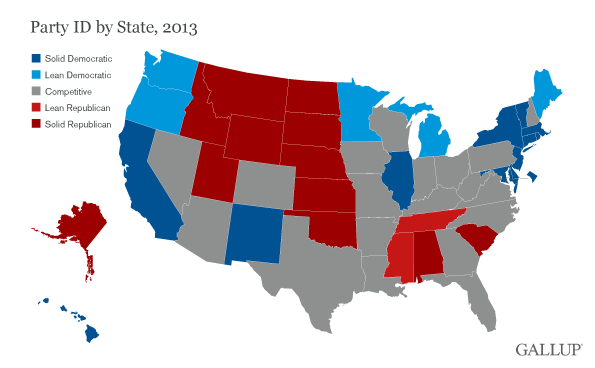

The Democratic Party is continuing to lose ground in the Gallup party ID by state survey, a trend that has continued since Gallup began measuring in 2008.
In 2013, Democratic states outnumbered Republican states by 3, but that represents a slide from a 7-state advantage in 2012, and an evaporation of their once-30-state advantage in 2008.
The single-most significant change in the party ID by state measurement in 2013 was the 3-state gain made by the Republican Party in solidly Republican states. According to Gallup, solidly Republican states are those states where Republicans outnumbered Democrats by at least 10 percentage points.
The three solidly Republican states were South Carolina, a state Democrats thought they had a real shot at making gains in, South Dakota and Oklahoma. The 3-state gain was slightly offset by a net loss of one Republican-leaning state. On the other hand, Democrats had net losses of one solid and one Democratic-leaning state, while the number of competitive states was unchanged.
The implication with respect to the 2014 midterm elections is a bit of an obfuscation, as it relates to Gallup reporting. Because Democrats lost ground in states where there are now highly competitive Senate races, which Democrats did not think they would have to defend, states like Michigan now give the Republicans a far better chance at taking the Senate.
As we have shown in the 2014 Senate Map Predictions on PeoplesPunditDaily.com, the Republican Party has greatly expanded the map over the last few months beyond what commentators and pundits have yet acknowledged.
Michigan, for instance, moved from solidly Democratic in 2012 to leaning Democratic in 2013, which makes the state of the 2014 Senate race in Michigan exactly how we called it, a “Toss-Up.”
Further, Alaska is now a full 20 points more Republican than in the previous year, and even far more Republican than when Mark Begich barely won his seat by just under 4,000 votes. The 2014 Alaska Senate race is rated “Leans Republican” on the PeoplesPunditDaily.com Senate Map Predictions, because the uncertainty of the GOP primary has kept it from moving to “Likely Republican” on our map.
The overall political orientation of the country stayed roughly the same in 2013 than it was in 2012, with the Democrats enjoying a 6-point advantage — 47 percent to 41 percent. In 2012, Democrats enjoyed a 5-point advantage — 47 percent to 42 percent. The Democratic increase — which is why the Generic Congressional Ballot is always more Democratic than actual Election Day results — came from highly populated, already-Democratic leaning states.
That will not help them to keep the Senate or win House seats.
The Democrats gained 3 points each in California, New Jersey, and New York, and gained 1 point in Illinois.
“The resulting four-state lead for Democrats in 2013 is far less than their 12-state lead in 2010 — a year with a wave election that swept out 63 House Democrats and established the current Republican majority,” Lydia Saad of Gallup correctly observed.
The most damning journalistic sin committed by the media during the era of Russia collusion…
The first ecological study finds mask mandates were not effective at slowing the spread of…
On "What Are the Odds?" Monday, Robert Barnes and Rich Baris note how big tech…
On "What Are the Odds?" Monday, Robert Barnes and Rich Baris discuss why America First…
Personal income fell $1,516.6 billion (7.1%) in February, roughly the consensus forecast, while consumer spending…
Research finds those previously infected by or vaccinated against SARS-CoV-2 are not at risk of…
This website uses cookies.